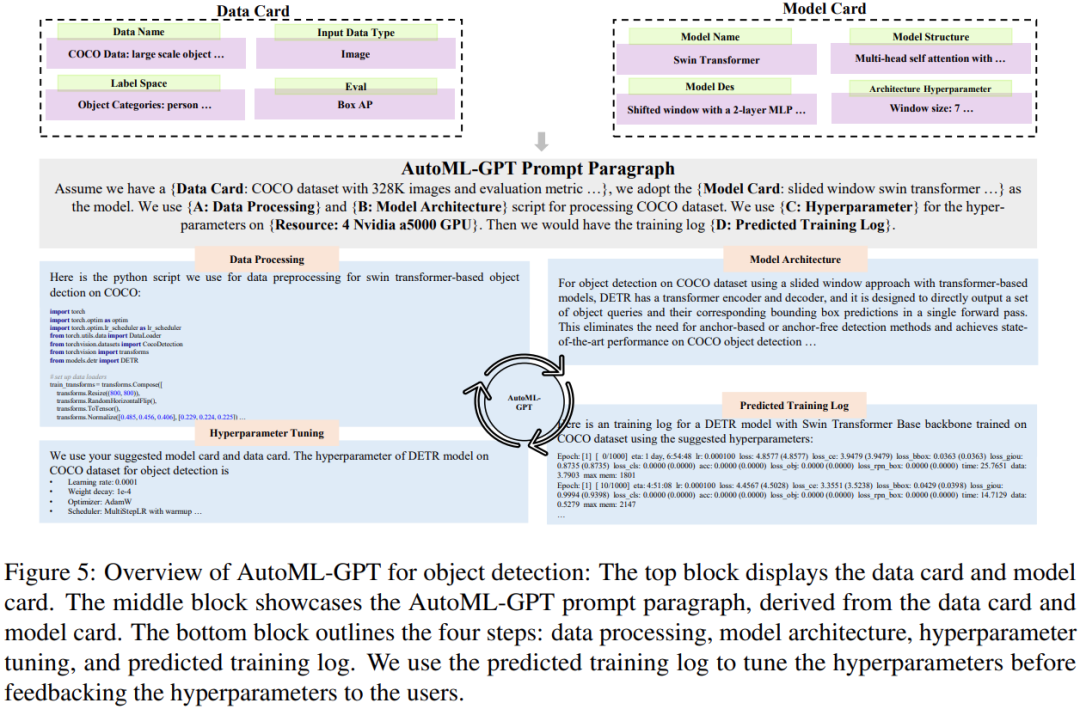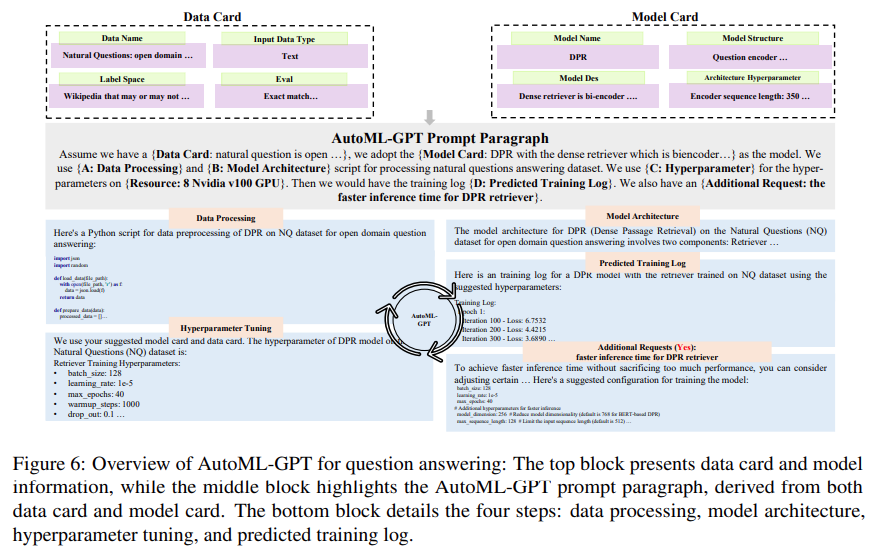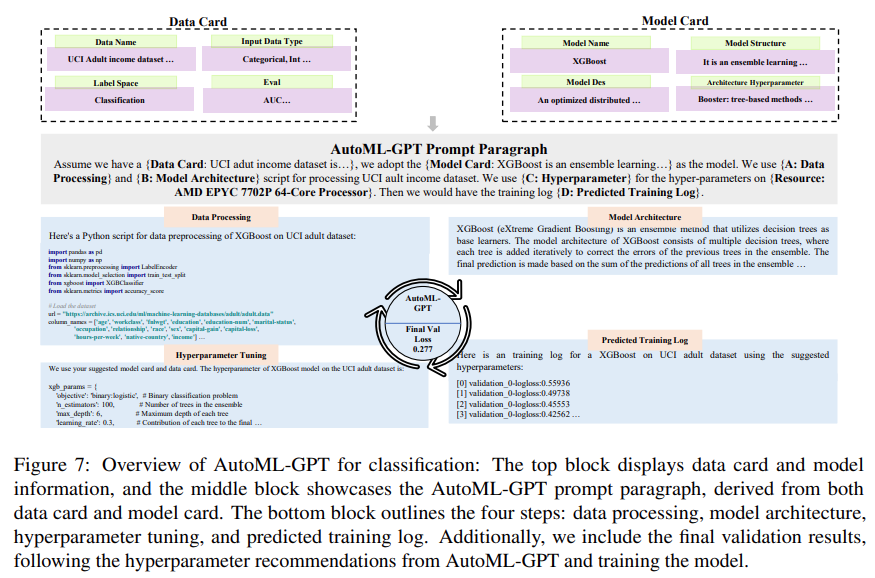 Technology peripherals
Technology peripherals
 AI
AI
 GPT acts as a brain, directing multiple models to collaborate to complete various tasks. The general system AutoML-GPT is here.
GPT acts as a brain, directing multiple models to collaborate to complete various tasks. The general system AutoML-GPT is here.
GPT acts as a brain, directing multiple models to collaborate to complete various tasks. The general system AutoML-GPT is here.
Currently, although AI models have been involved in a very wide range of application fields, most AI models are designed for specific tasks, and they often require a lot of manpower to complete the correct model architecture, optimization algorithms and hyperparameters. . After ChatGPT and GPT-4 became popular, people saw the huge potential of large language models (LLM) in text understanding, generation, interaction, reasoning, etc. Some researchers try to use LLM to explore new paths towards artificial general intelligence (AGI).
Recently, researchers from the University of Texas at Austin proposed a new idea - to develop task-oriented prompts and use LLM to automate the training pipeline, and based on this Idea launches a new system AutoML-GPT.

Paper address:
https: //www.php.cn/link/39d4b545fb02556829aab1db805021c3
AutoML-GPT uses GPT as a bridge between various AI models and uses optimized hyperparameters to dynamically train the model. AutoML-GPT dynamically receives user requests from Model Card [Mitchell et al., 2019] and Data Card [Gebru et al., 2021] and composes corresponding prompt paragraphs. Finally, AutoML-GPT uses this prompt paragraph to automatically perform multiple experiments, including processing data, building model architecture, tuning hyperparameters, and predicting training logs.
AutoML-GPT solves complex AI tasks across a variety of tests and datasets by maximizing its powerful NLP capabilities and existing AI models. A large number of experiments and ablation studies have shown that AutoML-GPT is versatile and effective for many artificial intelligence tasks (including CV tasks and NLP tasks).
Introduction to AutoML-GPT
AutoML-GPT is a collaborative system that relies on data and model information to format prompt input paragraphs. Among them, LLM serves as the controller, and multiple expert models serve as collaborative executors. The workflow of AutoML-GPT includes four stages: data processing, model architecture design, hyperparameter adjustment and training log generation.
Specifically, the working mechanism of AutoML-GPT is as follows:

- Through Model Card and Data Card generate fixed-format prompt paragraphs
- Build a training pipeline to handle user needs on the selected data set and model architecture
- Generate performance training logs and adjust hyperparameters
- Adjust the model based on auto-suggested hyperparameters
Input Decomposition
The first stage of AutoML-GPT is for LLM to accept user input. In order to improve the performance of LLM and generate effective prompts, this study adopts specific instructions for input prompts. These instructions include three parts: Data Card, Model Card, Evaluation Metrics and Additional Requirements.
As shown in Figure 2 below, the key parts of the Data Card consist of the data set name, input data set type (such as image data or text data), label space (such as category or resolution) and default evaluation indicators.

As shown in Figure 3 below, the Model Card consists of the model name, model structure, model description and architecture hyperparameters. By providing this information, the Model Card can tell LLM which models are used throughout the machine learning system, as well as the user's preferences for model architecture.

In addition to Data Card and Model Card, users can also choose to request more evaluation benchmarks, evaluation metrics, or any constraints. AutoML-GPT provides these task specifications as high-level instructions to LLM for analyzing user requirements accordingly.
When there is a series of tasks that need to be processed, AutoML-GPT needs to match the corresponding model for each task. In order to achieve this goal, the system first needs to obtain the model description from the Model Card and user input.
AutoML-GPT then uses the in-context task-model assignment mechanism to dynamically assign models to tasks. This approach enables incremental model access and provides greater openness and flexibility by combining model description with a better understanding of user needs.
Adjust hyperparameters using prediction training logs
AutoML-GPT sets hyperparameters based on Data Card and Model Card, And predict performance by generating training logs of hyperparameters. The system automatically performs training and returns training logs. Model performance training logs on the dataset record various metrics and information collected during the training process, which helps understand the model training progress, identify potential problems, and evaluate the effectiveness of the selected architecture, hyperparameters, and optimization methods .
Experiments
To evaluate the performance of AutoML-GPT, this study uses ChatGPT (OpenAI’s GPT-4 version) to implement it and conducts multiple experiments from multiple This perspective shows the effect of AutoML-GPT.
Figure 4 below shows the results of training on an unknown data set using AutoML-GPT:

Figure 5 below shows the process of AutoML-GPT completing the target detection task on the COCO data set:

Figure 6 below shows AutoML-GPT Experimental results on the NQ Open Dataset (Natural Questions Open dataset, [Kwiatkowski et al., 2019]):

This study also used XGBoost evaluated AutoML-GPT on the UCI Adult data set [Dua and Graff, 2017] to explore its performance on classification tasks. The experimental results are shown in Figure 7 below:

Interested readers can read the original text of the paper to learn more research details.
The above is the detailed content of GPT acts as a brain, directing multiple models to collaborate to complete various tasks. The general system AutoML-GPT is here.. For more information, please follow other related articles on the PHP Chinese website!

Hot AI Tools

Undresser.AI Undress
AI-powered app for creating realistic nude photos

AI Clothes Remover
Online AI tool for removing clothes from photos.

Undress AI Tool
Undress images for free

Clothoff.io
AI clothes remover

AI Hentai Generator
Generate AI Hentai for free.

Hot Article

Hot Tools

Notepad++7.3.1
Easy-to-use and free code editor

SublimeText3 Chinese version
Chinese version, very easy to use

Zend Studio 13.0.1
Powerful PHP integrated development environment

Dreamweaver CS6
Visual web development tools

SublimeText3 Mac version
God-level code editing software (SublimeText3)

Hot Topics
 1378
1378
 52
52
 ChatGPT now allows free users to generate images by using DALL-E 3 with a daily limit
Aug 09, 2024 pm 09:37 PM
ChatGPT now allows free users to generate images by using DALL-E 3 with a daily limit
Aug 09, 2024 pm 09:37 PM
DALL-E 3 was officially introduced in September of 2023 as a vastly improved model than its predecessor. It is considered one of the best AI image generators to date, capable of creating images with intricate detail. However, at launch, it was exclus
 Bytedance Cutting launches SVIP super membership: 499 yuan for continuous annual subscription, providing a variety of AI functions
Jun 28, 2024 am 03:51 AM
Bytedance Cutting launches SVIP super membership: 499 yuan for continuous annual subscription, providing a variety of AI functions
Jun 28, 2024 am 03:51 AM
This site reported on June 27 that Jianying is a video editing software developed by FaceMeng Technology, a subsidiary of ByteDance. It relies on the Douyin platform and basically produces short video content for users of the platform. It is compatible with iOS, Android, and Windows. , MacOS and other operating systems. Jianying officially announced the upgrade of its membership system and launched a new SVIP, which includes a variety of AI black technologies, such as intelligent translation, intelligent highlighting, intelligent packaging, digital human synthesis, etc. In terms of price, the monthly fee for clipping SVIP is 79 yuan, the annual fee is 599 yuan (note on this site: equivalent to 49.9 yuan per month), the continuous monthly subscription is 59 yuan per month, and the continuous annual subscription is 499 yuan per year (equivalent to 41.6 yuan per month) . In addition, the cut official also stated that in order to improve the user experience, those who have subscribed to the original VIP
 Context-augmented AI coding assistant using Rag and Sem-Rag
Jun 10, 2024 am 11:08 AM
Context-augmented AI coding assistant using Rag and Sem-Rag
Jun 10, 2024 am 11:08 AM
Improve developer productivity, efficiency, and accuracy by incorporating retrieval-enhanced generation and semantic memory into AI coding assistants. Translated from EnhancingAICodingAssistantswithContextUsingRAGandSEM-RAG, author JanakiramMSV. While basic AI programming assistants are naturally helpful, they often fail to provide the most relevant and correct code suggestions because they rely on a general understanding of the software language and the most common patterns of writing software. The code generated by these coding assistants is suitable for solving the problems they are responsible for solving, but often does not conform to the coding standards, conventions and styles of the individual teams. This often results in suggestions that need to be modified or refined in order for the code to be accepted into the application
 Can fine-tuning really allow LLM to learn new things: introducing new knowledge may make the model produce more hallucinations
Jun 11, 2024 pm 03:57 PM
Can fine-tuning really allow LLM to learn new things: introducing new knowledge may make the model produce more hallucinations
Jun 11, 2024 pm 03:57 PM
Large Language Models (LLMs) are trained on huge text databases, where they acquire large amounts of real-world knowledge. This knowledge is embedded into their parameters and can then be used when needed. The knowledge of these models is "reified" at the end of training. At the end of pre-training, the model actually stops learning. Align or fine-tune the model to learn how to leverage this knowledge and respond more naturally to user questions. But sometimes model knowledge is not enough, and although the model can access external content through RAG, it is considered beneficial to adapt the model to new domains through fine-tuning. This fine-tuning is performed using input from human annotators or other LLM creations, where the model encounters additional real-world knowledge and integrates it
 To provide a new scientific and complex question answering benchmark and evaluation system for large models, UNSW, Argonne, University of Chicago and other institutions jointly launched the SciQAG framework
Jul 25, 2024 am 06:42 AM
To provide a new scientific and complex question answering benchmark and evaluation system for large models, UNSW, Argonne, University of Chicago and other institutions jointly launched the SciQAG framework
Jul 25, 2024 am 06:42 AM
Editor |ScienceAI Question Answering (QA) data set plays a vital role in promoting natural language processing (NLP) research. High-quality QA data sets can not only be used to fine-tune models, but also effectively evaluate the capabilities of large language models (LLM), especially the ability to understand and reason about scientific knowledge. Although there are currently many scientific QA data sets covering medicine, chemistry, biology and other fields, these data sets still have some shortcomings. First, the data form is relatively simple, most of which are multiple-choice questions. They are easy to evaluate, but limit the model's answer selection range and cannot fully test the model's ability to answer scientific questions. In contrast, open-ended Q&A
 SOTA performance, Xiamen multi-modal protein-ligand affinity prediction AI method, combines molecular surface information for the first time
Jul 17, 2024 pm 06:37 PM
SOTA performance, Xiamen multi-modal protein-ligand affinity prediction AI method, combines molecular surface information for the first time
Jul 17, 2024 pm 06:37 PM
Editor | KX In the field of drug research and development, accurately and effectively predicting the binding affinity of proteins and ligands is crucial for drug screening and optimization. However, current studies do not take into account the important role of molecular surface information in protein-ligand interactions. Based on this, researchers from Xiamen University proposed a novel multi-modal feature extraction (MFE) framework, which for the first time combines information on protein surface, 3D structure and sequence, and uses a cross-attention mechanism to compare different modalities. feature alignment. Experimental results demonstrate that this method achieves state-of-the-art performance in predicting protein-ligand binding affinities. Furthermore, ablation studies demonstrate the effectiveness and necessity of protein surface information and multimodal feature alignment within this framework. Related research begins with "S
 SK Hynix will display new AI-related products on August 6: 12-layer HBM3E, 321-high NAND, etc.
Aug 01, 2024 pm 09:40 PM
SK Hynix will display new AI-related products on August 6: 12-layer HBM3E, 321-high NAND, etc.
Aug 01, 2024 pm 09:40 PM
According to news from this site on August 1, SK Hynix released a blog post today (August 1), announcing that it will attend the Global Semiconductor Memory Summit FMS2024 to be held in Santa Clara, California, USA from August 6 to 8, showcasing many new technologies. generation product. Introduction to the Future Memory and Storage Summit (FutureMemoryandStorage), formerly the Flash Memory Summit (FlashMemorySummit) mainly for NAND suppliers, in the context of increasing attention to artificial intelligence technology, this year was renamed the Future Memory and Storage Summit (FutureMemoryandStorage) to invite DRAM and storage vendors and many more players. New product SK hynix launched last year
 Laying out markets such as AI, GlobalFoundries acquires Tagore Technology's gallium nitride technology and related teams
Jul 15, 2024 pm 12:21 PM
Laying out markets such as AI, GlobalFoundries acquires Tagore Technology's gallium nitride technology and related teams
Jul 15, 2024 pm 12:21 PM
According to news from this website on July 5, GlobalFoundries issued a press release on July 1 this year, announcing the acquisition of Tagore Technology’s power gallium nitride (GaN) technology and intellectual property portfolio, hoping to expand its market share in automobiles and the Internet of Things. and artificial intelligence data center application areas to explore higher efficiency and better performance. As technologies such as generative AI continue to develop in the digital world, gallium nitride (GaN) has become a key solution for sustainable and efficient power management, especially in data centers. This website quoted the official announcement that during this acquisition, Tagore Technology’s engineering team will join GLOBALFOUNDRIES to further develop gallium nitride technology. G



